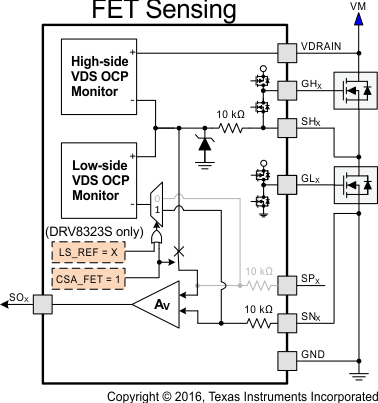TIDUCL0 January 2017
- 1 Description
- 2 Resources
- 3 Features
- 4 Applications
- 5 Design Images
- 6 System Overview
-
7 System Design Theory
- 7.1 Power Stage Design—Battery Power Input to the Board
- 7.2 Power Stage Design—Three-Phase Inverter
- 7.3 Power Stage Design—DRV8323 Gate Driver
- 7.4 Power Stage Design—18-V to 3.3-V DC-DC Converter
- 7.5 Power Stage Design —Microcontroller MSP430
- 7.6 Power Stage Design—Hall Sensor Interface
- 7.7 Temperature Sensing
- 7.8 Power Stage Design—External Interface Options and Indications
- 8 Getting Started Hardware and Software
- 9 Testing and Results
- 10Design Files
- 11Software Files
- 12Related Documentation
- 13Terminology
- 14About the Author
7.3.2 Current Shunt Amplifier in DRV8323
The sense amplifiers on the DRV8323S can be configured to amplify the voltage across the low-side FETs. During this mode of operation, leave the SPX pins unconnected. The positive input of the amplifier is internally connected to the SHX pin. An internal clamp prevents high voltage on the SHX pin from damaging the sense amplifier inputs.
When the CSA_FET bit is set to '1', the negative reference for the low-side VDS monitor is automatically set to SNX, regardless of the state of the LS_REF bit. This is implemented in order to prevent the low-side VDS monitor from being disabled. If the system is intended to operate in FET sensing mode, take care to route the SHX an SNX pins to kelvin connections across the drain and source of the low-side FETs.
When operating in FET sensing mode, the amplifier is enabled at the end of TDRIVE. At this time, the amplifier input is connected to SHX, and the SOX output will be valid. Whenever a low-side FET receives a signal to turn off, the amplifier inputs are shorted together. When GLX is low, SPX and SNX are internally shorted.
The current shunt amplifiers have the following features:
- Can be programmed and calibrated independently
- Can support bidirectional and unidirectional current sensing
- Four programmable gain settings through SPI registers (5, 10, 20, and 40 V/V)
- Programmable output bias scaling: VREF or VREF/2
- Programmable blanking time of the amplifier outputs
- Amplifier can be used to monitor current through half-bridges and the current is approximately calculated as in Equation 3:

Figure 6 shows the current sense amplifier simplified block diagram.
 Figure 6. DRV8323 Current Shunt Amplifier Simplified Block Diagram
Figure 6. DRV8323 Current Shunt Amplifier Simplified Block Diagram